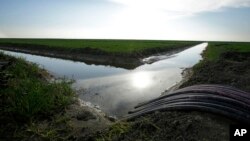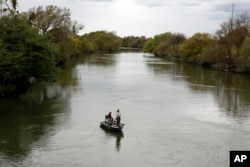Some lawmakers in the U.S. state of California want to use taxpayer money to buy out farmers.
A proposal in the state Senate would spend up to $1.5 billion for their “senior water rights.” That would permit farmers to take as much water as needed from the state’s rivers and streams to grow their crops. If state officials owned those rights, they could leave the water in the rivers to aid endangered salmon and other fish.
Severe drought in California
California has faced severe lack of water for most of the last 20 years. Lawmakers want to more closely examine the state’s complex water system to see how it might be changed to ensure continual supplies during especially dry periods. A separate state proposal would pay farmers to grow fewer crops to save water.
Currently, about 98 percent of the state has severe drought conditions. Summer months in California rarely produce any major rainfall. Many areas have begun restricting water use for homeowners. And farmers have had their water supply from the two major state-owned water systems reduced or, in some cases, completely shut off.
Legally, all the water in California is the property of the government. But farmers have “water rights” that let them take water for agriculture. Farmers have used those rights to turn California’s Central Valley into a major agricultural center. The area provides much of the nation’s fruits, nuts and vegetables.
Buying water rights from farmers
California now has a record budget surplus of nearly $100 billion. The $1.5 billion proposal to buy senior water rights would involve either buying the land connected with the rights or buying just the right itself. Lawmakers could also require that the water be used for fish and other animals and plants.
The proposal is part of budget negotiations between lawmakers and Gov. Gavin Newsom’s administration that should be completed by the end of this month.
Regulators measure water by “acre foot.” An acre foot is defined as enough water to cover 1 acre, or 0.4 hectares of land to a depth of 30 centimeters. That is the same amount as 1.2 million liters.
The $1.5 billion would be enough to buy about 200,000 acre feet of water. That amount is based on an average price of $7,500 per acre foot, says Tom Birmingham. He is the supervisor of Westlands Water District, the largest agricultural water district in the U.S.
Climate change demands quick action
Right now, the only way to get more water flowing in rivers and streams is to get state and federal regulators to change the rules. They can do that by requiring more water be left in rivers and streams. But that means less water for farmers. Those rule changes often bring about lawsuits that can take 10 years or longer to reach a decision, said Lester Snow. He is a former secretary of the California Natural Resources Agency and regional director of the U.S. Bureau of Reclamation.
“We need a way to take much quicker action. And I think acquiring water rights for that purpose is one of the ways to do that,” he said. “With climate change, we just don’t have that kind of time.”
For this to work, farmers would have to voluntarily sell their water rights. Tom Birmingham says that should not be a problem. Lots of farmers try to sell their water rights to Westlands Water District every year, he said.
Birmingham added, “For many farmers ... their children simply are not interested in continuing to farm.”
I’m Ashley Thompson.
Adam Beam reported on this story for the Associated Press. Jonathan Evans adapted this story for Learning English.
____________________________________________________________________
Words in This Story
acquire – v. to get, especially through effort
regulator – n. one that governs or directs according to rule or law










